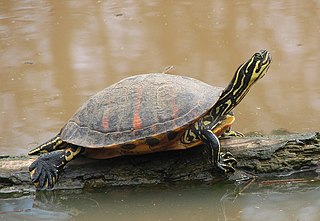Our understanding of the role that Ultraviolet B Light plays in the lives of reptiles and amphibians has increased greatly over the last few decades, but we still have much to learn about the needs of individual species. A good deal of conflicting information has been published, and opinions differ even among my well-experienced herpetologist colleagues. Today I’ll provide some basic information on UVB light in natural and captive situations, including some tips as to how best to provide it to the animals under your care. I’d like to stress that many variables will affect your individual situation…please post below for specific information.
What is Ultraviolet B (UVB) Light?
The various types of light are characterized by different wavelengths, which are expressed in nanometers (nm). There are three types of Ultraviolet Light, two of which are important to reptile and amphibian husbandry.
UVB Light has a wavelength of 280- 320 nm. Many reptiles synthesize Vitamin D3 (or, more specifically, Pre-Vitamin D/Cholecalciferol) in their skin when exposed to UVB light. The optimum range for Vitamin D3 synthesis in reptiles is 290-315 nm.
Why is UVB Needed?
Certain reptiles seem dependent upon skin-manufactured Vitamin D3, and cannot use D3 contained in the food that they eat. Therefore, vitamin supplements will not meet their needs. Rather, these reptiles must bask in the sun or under UVB-emitting bulbs.
Reptiles need Vitamin D3 in order to absorb and use Calcium. Without adequate supplies of both nutrients, a condition commonly known as Metabolic Bone Disease will develop. Afflicted animals pull Calcium from their bones and replace it with fibrous tissue, and in the process suffer growth deformities and difficulties in locomotion and feeding.
Which Animals Need UVB?
As far as we know, heliothermic reptiles – those that regularly bask in the sun – need UVB in order to produce Vitamin D3 in the skin. Examples include most semi-aquatic turtles and diurnal (day-active) lizards, and all tortoises and crocodilians. Some of these also seem able to use dietary Vitamin D3 to varying extents, but details are lacking and most do poorly if denied UVB exposure.
Snakes, Common Snapping Turtles and other aquatic turtles, and nocturnal lizards (i.e. Leopard Geckos) are able to obtain D3 from their food. Captives generally do fine without UVB light, provided that sufficient D3 is present in the diet. Many if not all can also manufacture D3 in the skin, so UVB bulbs may be useful as “insurance”.
Amphibians utilize dietary D3, and most seem not to require UVB exposure. There is some evidence, however, that low levels may be of use to Poison Frogs and other diurnal species. As field studies have shown that plant cover does not block all UVB, it follows that diurnal amphibians will receive some exposure. On the other hand, the skin and eggs of some amphibians contain chemicals that filter-out UVB. We still have a great deal to learn.
Providing UVB to Pet Reptiles and Amphibians
Natural sunlight is the best source of UVB, but please remember that overheating can occur quickly, and that UVB does not penetrate glass or most plastics. Screen cages offer options in some situations…please see this article for further information.
Florescent UVB Bulbs
In recent tests, the Zoo Med 5.0 and 10.0 Bulbs were found superior to several other models (please see this article). The highest UVB levels occur within 6 inches of the bulb; UVB output declines by 80-90% at 18 inches. Therefore, your pet’s basking site should be within 6-8 inches of the bulb.
Basking sites of varying distances should be provided, as reptiles will adjust their exposure as needed. Some chameleons, for example, modify their basking behavior in accordance with the Vitamin D3 content of their diets (please see article linked below). If a basking site cannot be arranged near the bulb, a shallow “basking enclosure” may be necessary…please post below for further information.
Florescent bulbs stop emitting UVB after a time, but will continue to give off visible light. Therefore, it is important to make a note of your bulb’s useful life. Zoo Med offers a free email “replacement reminder” service.
Florescent UVB Bulbs provide little heat. Situating one near an incandescent basking bulb will ensure that your pet receives UVB exposure each time it seeks warmth.
Halogen and Mercury Vapor UVB Bulbs
Halogen and Mercury Vapor Bulbs generally emit higher levels of UVB than florescent bulbs, and broadcast it over greater distances. They also give-off heat, and so may eliminate the need for an additional heat source.
Full Spectrum Bulbs
Aquarium bulbs labeled as “Full Spectrum” usually emit little if any UVB.
Which UVB Bulb is Best for my Pet?
Your pet’s natural will determine which UVB bulb to select. Unfortunately, however, few studies have been done on the specific needs of individual reptiles. But experience has provided important lessons…please post below for information on the animals in your collection.
In general, UVB exposure is very important to desert-dwellers, species that bask frequently in the wild, and young, growing individuals.
Low-output UVB bulbs, such as the Zoo Med 2.0 , are designed for use with Arrow Poison Frogs and other amphibians that may benefit from some exposure. If you decide to use a low output UVB, be sure to provide your frogs with shelters that allow them to avoid the light.
Measuring UVB
UVB meters provide an accurate means of measuring your pet’s exposure and will also enable you to keep track of the decline in UVB output as your bulbs age. As reflection from various surfaces, the type of terrarium cover used and other factors can radically affect the amount UVB that reaches your pet, a UVB meter is an essential item for every serious reptile keeper. Please post below for links to suppliers.
What About Ultraviolet A (UVA) Light?
UVA light has a wavelength of 320-400 nanometers. Although perhaps not essential, UVA can greatly improve your pet’s quality of life and breeding potential.
UVA helps regulate circadian rhythms, seasonal changes in activity levels, appetite and other important processes, and may be critical to successful reproduction in certain reptiles. Please see the article linked below for further information.
Further Reading
Providing UVA to Reptiles and Amphibians
Vitamin D and Chameleon Basking Behavior: an Interesting Study
 That Reptile Blog – Reptile, Amphibian and Exotic Pet Care and Information
That Reptile Blog – Reptile, Amphibian and Exotic Pet Care and Information






Hi Frank. We exchanged email a couple weeks ago. I asked whether I should get a 2nd canister filter for my 40 gall breeder tank, 7in painted turtle. I followed your advice by removing some gravel and feeding less. It’s been 2weeks and the tank is crystal clean. I scooped more gravel out tonight. I find the canister tubing gets coated with paste that slows the flow. Any thoughts? Cleaning is obvious but I’d like to extend this to monthly. I reconsidered the 2nd filter to balance the filtration. It’s amazing that one turtle blows away in filth compared to my 115 gall fresh water fish aquarium
Regards. Rob
Hi Rob.
Glad all is improving; I’m not sure another filter will help, due too the type of waste generated by turtles. Removing allgravel, frequent partial water changes and feeding outside the tank is the most effective way to keep the water clean. Enjoy, best, frank
Frank,
Ive read many of your articles and enjoy reading your responses to people as well. I recently went to the national zoo in DC and noticed they were using reptisun 5.0 T8 flourescent tubes which I use as well for fire belly toads. I also use these for my two northern green frogs. I have tried the naturesun 2.0 bulbs, but the frogs seem to prefer the 5.0’s. I have screen lids on all my tanks and they are high. My question is what is your opinion on this?
Hi Andy,
Thanks for the interesting posts; I have always used a 2.0, or no UVB at all. I’ve not had any feedback re a 5.0, other than some possible eye problems with various treefrogs, in tanks where there was little cover. Both species, especially green frogs, do receive sun exposure in the wild…I think well worth more experimentation; provide cover so that frogs can move away from light if need be…please keep me posted, best, frank
Hi,
Thank you so much for that great article on herps’ UVB/UVA needs. I have 3 Western (also sometimes called “Californian”) toadlets, recently metamorphed from tadpoles & eating great. They eat aphids and flightless fruit flies- being about 1/4″, that’s a mouthful for them! My question is since they are growing so rapidly, should I be dusting their bugs with Vitamin D &/or calcium?
I read on another site that they are mainly nocturnal so do not need a UVB light set up–they are Very active in the day though, so I kinda doubt that statement. I would love to hear your thought on the lighting. Do toads need lights?
These guys live for decades given optimum care, so I really want to ensure a good life for them. I appreciate any advice you are willing to share.
Thanks again for a great site!
Kathleen
While there is still some debate as to whether or not they need UVB in captivity, I usually recommend using a 5.0 fluorescent just in case. I would also supplement with a good D3 and multivitamin supplement weekly. Good luck, and have fun with your toads!
-Josh